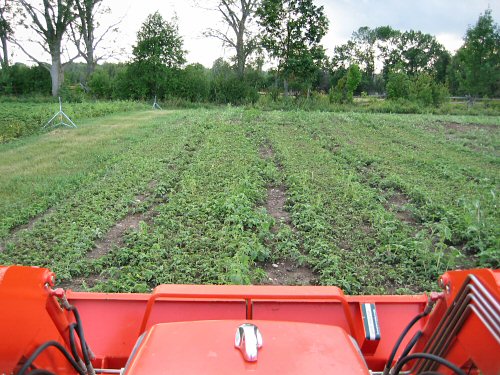
There’s no exaggerating the amount of pigweed in some sections of the field. Here, where the last seedings of spinach and peas failed—really poor germination in the heat—pigweed happily took over in no time. I mowed it down, and now I’m going in with the 48″ rototiller, prepping for fall spinach. Ideally, I’d keep the rototilling and any heavy gear off the garden beds, but this is practically an emergency. I apply the in-moderation rule here… It’s growing on me that round about next year, much of the pigweed seed, deposited three years ago in two-year-old manure, is due to expire… Right now, though, the seed seems pretty healthy to me.




Hope the problem with the Pigweed goes away–like the other poster commented a while back–careful all that tilling doesn’t create lots of Pigweed cuttings that will take root…
Our garden is small so we have the luxury of mulching everything–virtually no weeds and very little watering. We can get the native tree mulch(Pecan,Oaks, etc.) very inexpensively from a local supplier–on a larger scale like yours it may be impractical.
Really enjoying reading your blog, keep up the great work. And thanks for letting us know how far north you are!
Steve: Yes, I hope the pigweed problem just…goes away, too!! :) I’m next to positive about the source of the seed, it’s apparently viable for five years, and that expiry date is approaching, so…the “it’ll vanish” theory sounds good to me, though I’ll truly believe it when I see it. Cut up pieces haven’t been a problem, they usually dry out. It’s all generating from seed, we wipe out millions of seedlings at the seed leaf stage, and some sections like this just get away for a bit… The tractor is a last resort. I wish I could mulch more, but the only half-imaginable way right now is to use plastic, which I’m not partial to (use it only on melons), plus requires drip tape for irrigation, which we’re not yet set up to do… Oh well!
I wouldn’t feed young plants to rabbits or any livestock! The young plants are high in oxalates and nitrates which cause poisoning if eaten in large quantities…the same applies to humans when this Amaranthus retroflexus as well as the other species are ate as greens; which they are in many parts of the world. I assume those peoples who have eaten this for hundreds of years probably know when it’s the right time to be harvested and consumed. So if you have rabbits I suggest small amounts :)
Also did you know that Amaranth residues can have an allelopathic effect in the soil causing poor germination in some plants? Don’t know how true this is, but just something I’ve read. Have you noticed any difference with the large quantities tilled in?
Vera: That’s all interesting stuff about amaranth. There’s always so much more to learn. I wouldn’t be surprised if the allelopathic effect thing panned out, seeing how hardy and resourceful pigweed is at surviving when crowded, when cut, when mulched over…why not kill off the competition as well! I haven’t noticed any poor germination patterns that I might attribute to this, there are usually so many other factors present, like super hot, dry weather and not enough moisture… And I’m not sure how much residue might be involved, because I don’t till in that much, it generally gets pulled. But I definitely have residue in there. I’ll keep an extra eye out… Thanks for the info!
Pigweed is edible and is more nutritious than spinach. Just eat the pigweed! There are many recipes on the internet.
Hi there,
I’ll second eating the pigweed. And yes, it’s got oxalates, but so does spinach. (It is toxic to horses, but a horse would have to eat A LOT of it.) Get this – they’re actually selling it at an organic market here in Toronto as a gourmet green at $5 for a small bunch. If pigweed grows so readily there, why not try to grow “true” grain amaranth? It’s more nutritious than the spinach you’re trying to grow, and there’s probably a growing market – there’s plenty of 100-milers out there who would kill for some local amaranth grain, and plenty of other cultures eat it as a green. For seed, Salt Spring Seeds carries it.
I’d be your first customer! :-)
I pick, eat, sell and enjoy many wild edibles of which Amaranth is one. The nutrients in Amaranth have been used by indigenous peoples for convalescents and elderly for centuries and is now being looked at as a “food” for the starving in Africa. Enjoy your pigweed!!!
When I had my 8 acre veggie-ranch some 35-odd years ago (Many of those years have been very odd) I recall reading in an AG Ministry booklet that each pigweed plant can produce 76,000 seeds each of which can remain viable for 72 years.
OK, it;s a slow response, but how did it work out for you..?
Mexicans eat pigweed. They call them quelites (kay-leet-ease). I was driving down some country roads near some recently tilled wheat fields with some Mexican friends of mine and they got all excited and demanded me to stop. They filled bags and bags with Pigweed. later they told me how much they enjoyed finding these and eating them. it was only rescently that I realized that the quelites they were excited about was pig weed. They siad that they buy them in Mexican markets in Mexico. BTW, Mexicans are very nice and fun people to be around.
Check into a product Revolution 2.0! When added to glyphosate it makes it 24times stronger and gets directly into the bloodstream of resistant hard to kill weeds!